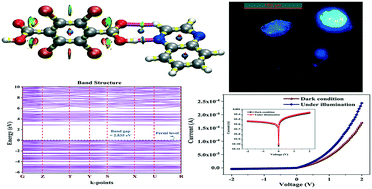Photo-responsive Schottky diode behavior of a donor–acceptor co-crystal with violet blue light emission†
Abstract
Herein, we report the crystal structure, supramolecular structure, electronic transport properties and optoelectronic behaviour of a co-crystal made of tetrabromoterephthalic acid (TBTA) and quinoxaline (QUIN) (1 : 1). The sample has been characterized using thermogravimetric analysis and spectral techniques. Moreover, theoretical analyses of noncovalent interactions, optical properties and the band structure of the co-crystal have been performed. The co-crystal has been crystallized in an orthorhombic system with the Pnma space group and the constituent molecules assemble in the solid state by using O–H⋯N hydrogen bonding, π⋯π, Br⋯π and Br⋯O interactions. The ground state geometry optimization over the hydrogen bonded dimer by DFT method indicates that TBTA acts as the donor and QUIN as the acceptor within the self-assembled co-crystal. According to UV-vis spectroscopic study the bandgap of the co-crystal is ∼3.18 eV. In the solid state it exhibits a broad emission band with a maximum at 405 nm while in aqueous medium its photoluminescence emission peaks are obtained at 350 and 403 nm. The values of the average fluorescence lifetime of the sample in aqueous medium are 3.38 ns at 352 nm and 4.94 ns at 403 nm. Under UV-irradiation, the co-crystal emits violet-blue light. The emission spectrum in solution phase shows a relative quantum yield of 0.018. Band structure calculation indicates that the co-crystal is a p-type semiconductor with a bandgap of 2.835 eV. Due to its semiconducting character, the ITO/co-crystal/Al sandwiched structured device acts as a Schottky barrier diode with rectification ratio, ideality factor, barrier height and series resistance of 41, 1.36, 0.70 eV, and 26.97 kΩ, respectively. The current through the device increases substantially under visible light exposure. Upon visible light illumination the values of electrical conductivity, mobility and carrier concentration increase by 35 (±0.5), 54 (±0.5) and 6 (±0.5)%, respectively, with respect to dark conditions. It has been shown that π⋯π and hydrogen bonding interactions can play a crucial role in producing the donor–acceptor (D–A) type co-crystal, semiconducting behaviour can be incorporated in the organic co-crystal utilizing π⋯π and hydrogen bonding interactions and weak intermolecular π⋯π, Br⋯π and Br⋯O interactions can act as the pathway for electrical conduction.

- This article is part of the themed collection: Supramolecular & Polymorphism


 Please wait while we load your content...
Please wait while we load your content...